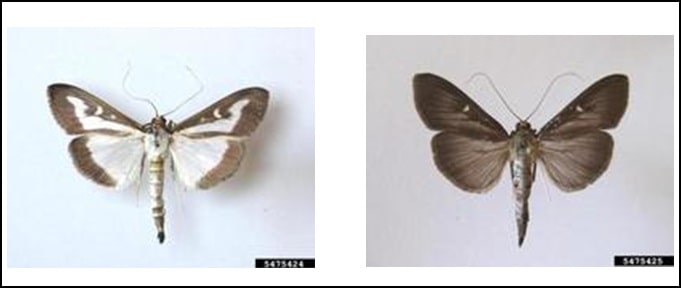BEST Boxwood Tree Moth Treatment Near You
Do you have Boxwood hedges or shrubs in the Greater Toronto Area? We can help! (4 min. read)
There is a new, damaging insect pest called a Boxwood Tree Moth – or Box Tree Moth – that secretly eats and destroys your boxwood plants from the inside out.
Boxwoods (buxus) are beautiful broadleaf evergreens that are often carefully and meticulously trimmed to all shapes and sizes, especially as hedges. They are normally found framing a walkway, adding a touch of formality and elegance to your home and they always add some year-round ‘evergreen’ to many of the Toronto area’s most beautiful Gardens.
What Are Boxwood Caterpillars & the Boxwood Tree Moth (BTM)?
The Boxwood Tree Moth (BTM), Cydalima perspectalis, is a new insect pest that has been quickly damaging Boxwoods in Ontario.  First discovered in 2018 in Etobicoke, this invasive pest has been spreading throughout the Greater Toronto Area, and now Ontario and East through Canada, causing significant concern among gardeners, lawn & tree professionals and arborists alike.
First discovered in 2018 in Etobicoke, this invasive pest has been spreading throughout the Greater Toronto Area, and now Ontario and East through Canada, causing significant concern among gardeners, lawn & tree professionals and arborists alike.
What Is Killing Boxwoods in Ontario?
The Box Tree Moth has already established itself as a significant threat to the health of our beloved Boxwood trees, and our understanding of it continues to grow as research develops each year.
This article aims to shed light on this evolving situation, provide some understanding of the biological lifecycle of the BTM, and explain how best to mitigate its impact on your Boxwoods.
The Biology and Lifecycle of the Boxwood Tree Moth
 The biology of BTM varies significantly based on geographical location, larval food source, and temperature. Adult moths live about 14 days and have the potential to disperse 7-10 km per year. Eggs are laid on the underside of host leaves, usually in a cluster of about 10-20 eggs.
The biology of BTM varies significantly based on geographical location, larval food source, and temperature. Adult moths live about 14 days and have the potential to disperse 7-10 km per year. Eggs are laid on the underside of host leaves, usually in a cluster of about 10-20 eggs.
After about 3 days, the eggs hatch and young larvae feed on the underside of the leaves. This feeding activity results in webbing the leaves, one of the most obvious signs of an infestation.
The BTM can have between 1 to 5 generations a year, influenced by geographical location and developmental temperature. This means we have a 14-day window each generation in which we can treat. The BTM overwinters in the larval stage in a silken cocoon spun between host leaves, able to survive in temperatures as low as -30°C.
temperatures as low as -30°C.
The Phenological Cycle of Boxwood Tree Moth (BTM): Why Timing Matters
Phenology refers to the timings of cyclical or seasonal biological events, such as migrations, egg laying, flowering, and hibernation. Timing for all pest treatments on turf and trees is influenced by the phenological cycle, with temperature being a significant factor. Getting it right helps to stop the damage!
 In the case of the Boxwood Tree Moth, treating the pest aligns with the phenological cycle. Each year, the timing for treatments may vary, reflecting changes in temperature patterns and the lifecycle stages of the BTM.
In the case of the Boxwood Tree Moth, treating the pest aligns with the phenological cycle. Each year, the timing for treatments may vary, reflecting changes in temperature patterns and the lifecycle stages of the BTM.
The Boxwood Tree Moth in Canada
In August 2018, the BTM was detected in a neighborhood in Etobicoke, part of Toronto, Ontario. The introduction source remains unknown, and its footprint in the region has been expanding ever since.
How to Control the Box Tree Moth
Biological Control is a key tool in our arsenal against the Boxwood tree Moth. We use a biological insecticide applied topically to the plants. However, it’s important to understand that the treatment is not a contact poison. It must be ingested by the larva (caterpillars) to be effective and isn’t effective against eggs, pupae, or adult life stages.
 Applications should be made during each larval stage for effective suppression of the population. Expect a minimum of three generations per year with the first larval stage active from:
Applications should be made during each larval stage for effective suppression of the population. Expect a minimum of three generations per year with the first larval stage active from:
- Early-May to mid-June;
- Mid-July to mid-August;
- and the third preparing to overwinter in late September;
- Early September to Late September
(ALL RANGES depend on weather/heat cycles)
How Quickly Will the BTM Eat My Boxwoods?
The BTM works fast and there are at least 3 or more generations per year! Just watch this video to see how quickly they can destroy a hedge Credit: Roman Willi, www.romanwilli.com
Will My Boxwood Trees Survive BTM Damage?
According to Landscape Ontario’s researchers in conjunction with the University of Guelph; If caught early enough, many hedges or plants will survive if they receive the proper treatment, and care starting now!
Call us right away to discuss your treatment options at 416-707-9994
More background information from Landscape Ontario is available by clicking here.
Get Treatment for Box Tree Moth & Boxwood Caterpillars in GTA
 At LawnSavers, we understand how passionate you are about your garden and lawn. We are committed to supporting you through the challenges posed by pests such as the Boxwood Tree Moth. However, as much as we wish we could, we cannot guarantee complete prevention or elimination of these issues. Our role is to support you towards a healthy landscape within the confines and restraints of Law, Regulations, and Science, combined with the unpredictable whims of weather and Mother Nature.
At LawnSavers, we understand how passionate you are about your garden and lawn. We are committed to supporting you through the challenges posed by pests such as the Boxwood Tree Moth. However, as much as we wish we could, we cannot guarantee complete prevention or elimination of these issues. Our role is to support you towards a healthy landscape within the confines and restraints of Law, Regulations, and Science, combined with the unpredictable whims of weather and Mother Nature.
That said, we’re ready to help you navigate this challenge! Our experts, guided by up-to-date research from sources like the Ministry’s OMAFRA Tree expert for Ontario, (Ontario Ministry of Agriculture, Food and Rural Affairs), are here to help you protect your Boxwoods from the BTM.
We aim to “Make you say WOW” with our commitment to your garden’s health. Fill out the form on the right side or bottom of this page to contact us today, and together, let’s protect your Boxwoods to ensure their beauty endures!






